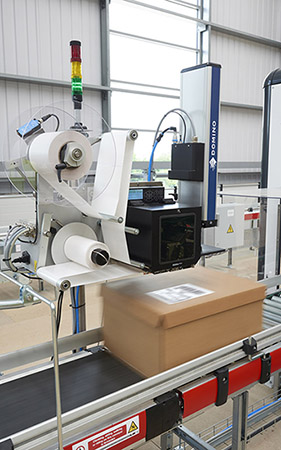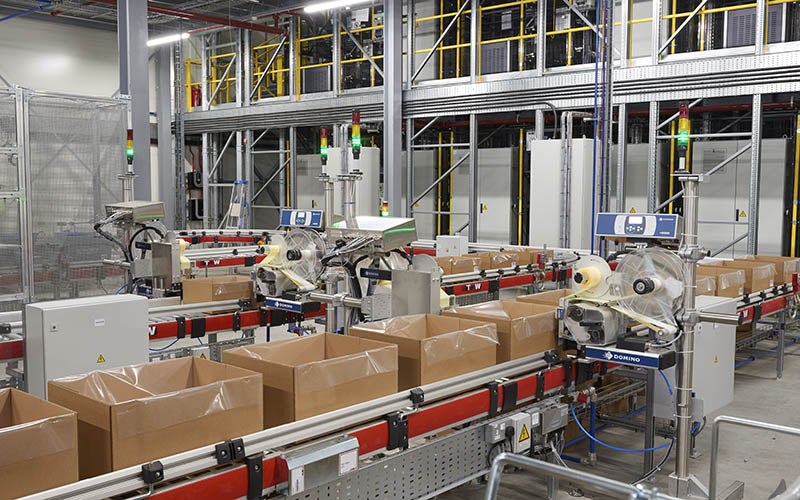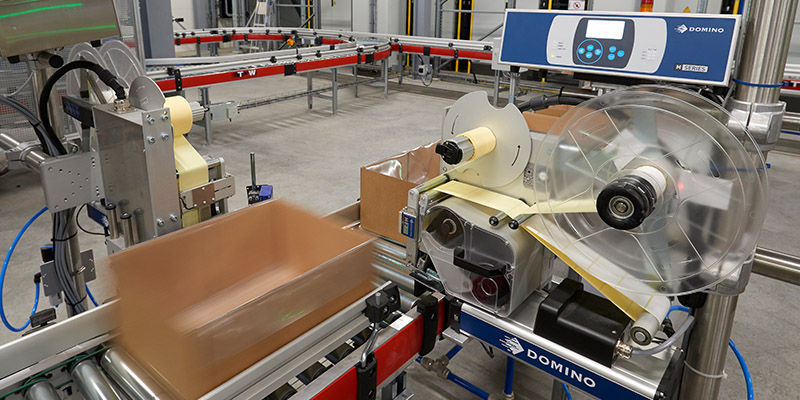Overview
The despatch, track and trace of several thousand multi-product cartons leaving a UK distribution centre daily have been boosted by a warehouse automation programme with a Domino Print & Apply labelling solution.
UK-based global logistics, storage and warehouse automation provider TGW Ltd picked Domino’s M-Series machines to deliver three separate levels of machine-readable coding (MRC) to its global client.
![]()
Fast Facts
- TGW is a UK-based global logistics, storage and warehouse automation provider
- Domino’s M-Series print and apply labellers deliver three separate levels of machine-readable coding (MRC)
- Global growth in online shopping models is driving demand for increased automation and more effective distribution
- Solutions such as this are transferable to diverse e-commerce and fulfilment centre applications
“The team never once let us down and I will always
consider using Domino in the future”Trevor Chesterton - TGW Project Manager

Trackable up to point of delivery
Cartons had to remain trackable both within the UK-based warehouse – bigger than the total area of three professional football pitches – and right up to the point of delivery to a network of retailers within the UK.
TGW Project Manager Trevor Chesterton said Domino’s offering represented “a high quality, reliable and cost-effective alternative to incumbent suppliers”.
“Domino accommodated a difficult and fluid set of requirements from TGW and balanced our client’s precise specifications to negotiate the best solution.”
As part of the project, Domino tailored its solution to seamlessly integrate with the end client’s shipper labelling processes. It was also designed to be fully compatible with the Zebra technology used by the end client’s despatch systems.

Fully transferable across e-commerce
Domino’s OEM Sales Manager David Edwards described TGW’s solution as fully transferable. “We have both the market-leading products, and the technical expertise, to provide Print & Apply labelling solutions into the full gamut of e-commerce and fulfilment centres.
“What is key is our ability to be flexible with respect to the solution we provide. We have a broad range of label applicator styles and we’re able to Print & Apply labels of all sizes, in any orientation, quickly and effectively. We can also configure our systems’ digital I/O to accommodate the control preferences of the automation provider. Our project managers can provide solutions that are tailored to the specific needs of our customers.
“We can even accommodate specific, third-party print engines – like Zebra – where needed. The options for the integration of our systems are far-reaching,” Edwards added.

Improved traceability in-house…
To ensure the trackability within the distribution centre itself, each carton is issued a unique serial number at the point of assembly. Applied to both sides of the carton in the form of a barcode, the serial number is printed on a label known as its licence plate. Domino provided two pairs of licence plate labellers, one pair per line with each pair controlled via its own PAC (Print Automation Controller) Box. The PAC Box is a self-contained, programmable console that manages digital input/output signals as well as protocol/comms data.
TGW designed the system to stop the carton and issue a signal to the PAC box, thereby initiating the Print & Apply cycle for both machines. Once both sides of the carton are labelled, a cycle complete signal is returned which initiates the box’s release. As the box is released onto its conveyor, barcode scanners mounted on both sides of the line confirm they were printed and applied correctly.
An additional sensor provides a signal to the PAC box to increment the barcodes’ serial numbers. Then, once the carton has been sent out for delivery, the role of the licence plate label has succeeded.

… and better supply chain management
A serial shipping container code (SSCC) solution was also incorporated into the project. It means that as well as printing labels containing the full despatch address details on each carton or tote leaving the centre, SSCC barcodes are included too.
Around a third of the outgoing cartons require an SSCC code, which is generally an 18-digit number that identifies logistics units via an automated reading process.
It was key that Domino’s tracking solution would be fully compatible with courier partner logistics systems as this guaranteed confirmation when cartons reached the designated retailer or fulfilment centre.
Once the cartons are packed, trimmed and closed, additional M230i machines Print & Apply the shipper labels, with addressee details and courier MRCs ready for despatch. The data for these labels is managed by TGW and sent to Domino machines over Ethernet.
For TGW, Domino’s expertise and personalised service ticked all of Chesterton’s Print & Apply boxes. “The team never once let us down and I will always consider using Domino in the future,” he said.
“Domino accommodated a difficult and fluid set of requirements from TGW and balanced our client’s precise specifications to negotiate the best solution.”Trevor Chesterton - TGW Project Manager